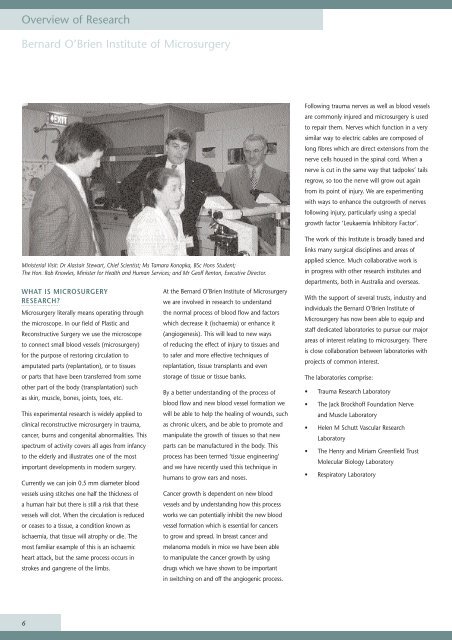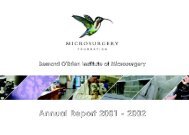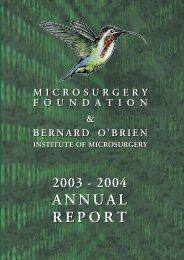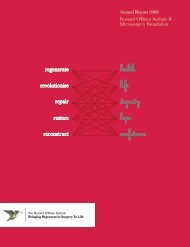2990 Microsurgery.qxd - O'Brien Institute
2990 Microsurgery.qxd - O'Brien Institute
2990 Microsurgery.qxd - O'Brien Institute
You also want an ePaper? Increase the reach of your titles
YUMPU automatically turns print PDFs into web optimized ePapers that Google loves.
Overview of Research<br />
Bernard O’Brien <strong>Institute</strong> of <strong>Microsurgery</strong><br />
Following trauma nerves as well as blood vessels<br />
are commonly injured and microsurgery is used<br />
to repair them. Nerves which function in a very<br />
similar way to electric cables are composed of<br />
long fibres which are direct extensions from the<br />
nerve cells housed in the spinal cord. When a<br />
nerve is cut in the same way that tadpoles’ tails<br />
regrow, so too the nerve will grow out again<br />
from its point of injury. We are experimenting<br />
with ways to enhance the outgrowth of nerves<br />
following injury, particularly using a special<br />
growth factor ‘Leukaemia Inhibitory Factor’.<br />
Ministerial Visit: Dr Alastair Stewart, Chief Scientist; Ms Tamara Konopka, BSc Hons Student;<br />
The Hon. Rob Knowles, Minister for Health and Human Services; and Mr Geoff Renton, Executive Director.<br />
WHAT IS MICROSURGERY<br />
RESEARCH?<br />
<strong>Microsurgery</strong> literally means operating through<br />
the microscope. In our field of Plastic and<br />
Reconstructive Surgery we use the microscope<br />
to connect small blood vessels (microsurgery)<br />
for the purpose of restoring circulation to<br />
amputated parts (replantation), or to tissues<br />
or parts that have been transferred from some<br />
other part of the body (transplantation) such<br />
as skin, muscle, bones, joints, toes, etc.<br />
This experimental research is widely applied to<br />
clinical reconstructive microsurgery in trauma,<br />
cancer, burns and congenital abnormalities. This<br />
spectrum of activity covers all ages from infancy<br />
to the elderly and illustrates one of the most<br />
important developments in modern surgery.<br />
Currently we can join 0.5 mm diameter blood<br />
vessels using stitches one half the thickness of<br />
a human hair but there is still a risk that these<br />
vessels will clot. When the circulation is reduced<br />
or ceases to a tissue, a condition known as<br />
ischaemia, that tissue will atrophy or die. The<br />
most familiar example of this is an ischaemic<br />
heart attack, but the same process occurs in<br />
strokes and gangrene of the limbs.<br />
At the Bernard O’Brien <strong>Institute</strong> of <strong>Microsurgery</strong><br />
we are involved in research to understand<br />
the normal process of blood flow and factors<br />
which decrease it (ischaemia) or enhance it<br />
(angiogenesis). This will lead to new ways<br />
of reducing the effect of injury to tissues and<br />
to safer and more effective techniques of<br />
replantation, tissue transplants and even<br />
storage of tissue or tissue banks.<br />
By a better understanding of the process of<br />
blood flow and new blood vessel formation we<br />
will be able to help the healing of wounds, such<br />
as chronic ulcers, and be able to promote and<br />
manipulate the growth of tissues so that new<br />
parts can be manufactured in the body. This<br />
process has been termed ‘tissue engineering’<br />
and we have recently used this technique in<br />
humans to grow ears and noses.<br />
Cancer growth is dependent on new blood<br />
vessels and by understanding how this process<br />
works we can potentially inhibit the new blood<br />
vessel formation which is essential for cancers<br />
to grow and spread. In breast cancer and<br />
melanoma models in mice we have been able<br />
to manipulate the cancer growth by using<br />
drugs which we have shown to be important<br />
in switching on and off the angiogenic process.<br />
The work of this <strong>Institute</strong> is broadly based and<br />
links many surgical disciplines and areas of<br />
applied science. Much collaborative work is<br />
in progress with other research institutes and<br />
departments, both in Australia and overseas.<br />
With the support of several trusts, industry and<br />
individuals the Bernard O’Brien <strong>Institute</strong> of<br />
<strong>Microsurgery</strong> has now been able to equip and<br />
staff dedicated laboratories to pursue our major<br />
areas of interest relating to microsurgery. There<br />
is close collaboration between laboratories with<br />
projects of common interest.<br />
The laboratories comprise:<br />
• Trauma Research Laboratory<br />
• The Jack Brockhoff Foundation Nerve<br />
and Muscle Laboratory<br />
• Helen M Schutt Vascular Research<br />
Laboratory<br />
• The Henry and Miriam Greenfield Trust<br />
Molecular Biology Laboratory<br />
• Respiratory Laboratory<br />
6






